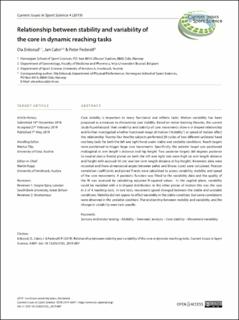| dc.contributor.author | Eriksrud, Ola | |
| dc.contributor.author | Cabri, Jan | |
| dc.contributor.author | Federolf, Peter Andreas | |
| dc.date.accessioned | 2020-05-08T10:26:40Z | |
| dc.date.available | 2020-05-08T10:26:40Z | |
| dc.date.created | 2019-12-13T15:26:09Z | |
| dc.date.issued | 2019 | |
| dc.identifier.citation | Current Issues in Sport Science. 2019, 4, 007. | en_US |
| dc.identifier.issn | 2414-6641 | |
| dc.identifier.uri | https://hdl.handle.net/11250/2653716 | |
| dc.description.abstract | Core stability is important to many functional and athletic tasks. Motion variability has been proposed as a measure to characterize core stability. Based on motor learning theories, the current study hypothesized that variability and stability of core movements show a U-shaped relationship and further investigated whether functional range of motion (“mobility”) or speed of motion affect this relationship. Twenty-four healthy subjects performed 20 cycles of two different unilateral hand reaching tasks for both the left and right hand under stable and unstable conditions. Reach targets were positioned to trigger large core movements. Specifically, the anterior target was positioned midsagittal at arm length ́s distance and hip height. Two posterior targets (60 degrees posterior to neutral stance frontal plane) on both the left and right side were high (at arm length distance and height with accrued 10 cm) and low (arm length distance at hip height). Kinematic data were recorded and three-dimensional angles between pelvis and thorax (core) were calculated. Pearson correlation coefficients and paired T-tests were calculated to assess variability, mobility and speed of the core movements. A parabolic function was fitted to the variability data and the quality of the fit was assessed by calculating adjusted R-squared values. In the sagittal plane, variability could be modeled with a U-shaped distribution; in the other planes of motion this was the case in 2 of 4 reaching tests. In two tests, movement speed changed between the stable and unstable conditions. Mobility did not appear to affect variability in the stable condition, but some correlations were observed in the unstable condition. The relationship between mobility and variability, and the change in variability were task-specific. | en_US |
| dc.language.iso | eng | en_US |
| dc.subject | sensory and motor testing | en_US |
| dc.subject | mobility | en_US |
| dc.subject | kinematic analysis | en_US |
| dc.subject | core stability | en_US |
| dc.subject | movement variability | en_US |
| dc.title | Relationship between stability and variability ofthe core in dynamic reaching tasks | en_US |
| dc.type | Peer reviewed | en_US |
| dc.type | Journal article | en_US |
| dc.description.version | publishedVersion | en_US |
| dc.rights.holder | Open access. | en_US |
| dc.source.pagenumber | 10 | en_US |
| dc.source.volume | 4 | en_US |
| dc.source.journal | Current Issues in Sport Science | en_US |
| dc.identifier.doi | 10.15203/CISS_2019.007 | |
| dc.identifier.cristin | 1760674 | |
| dc.description.localcode | Seksjon for fysisk prestasjonsevne / Department of Physical Performance | en_US |
| cristin.unitcode | 150,31,0,0 | |
| cristin.unitname | Seksjon for fysisk prestasjonsevne | |
| cristin.ispublished | true | |
| cristin.fulltext | original | |
| cristin.qualitycode | 1 | |
